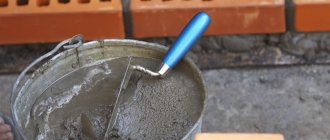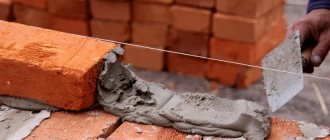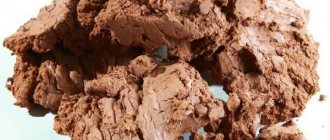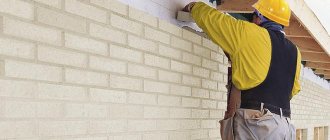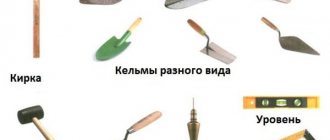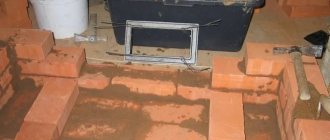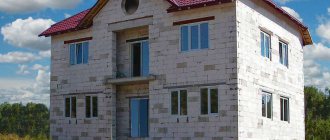Various types of mortars are used in the construction of buildings. The use of one or another composition is determined by many circumstances such as the season of work, the height of the structure being built, the type of building materials and many others. Let's take a closer look at how the mortar for laying bricks is prepared.
Masonry mortar on a trowel Source shuterzbut.com.ua
Types of solutions
Despite the enormous amount of time6 during which the art of building construction has been developing, at the moment there are only three types of masonry mortar:
- lime
- cement-lime
- cement.
The first type of composition is used quite rarely, this is due to low strength indicators. Meanwhile, it is widely used to improve the quality of compositions with Portland cement. The second type of masonry mortar consists of sand, Portland cement and slaked lime.
For slaking, ordinary water is used, which is added until the lime reaches the consistency of milk. After this procedure, the sand and binder are mixed, and the prepared lime milk is poured into the composition. As a result, the masonry mortar for bricks turns out to be much more plastic than classic compositions with Portland cement. This bricklaying mixture is ready for use on almost any type of masonry work.
The standard mortar for bricklaying, its proportions will be indicated below, is prepared from three components - water, sand and Portland cement. The proportions of sand and binder in such compositions almost entirely depend on the marking of the cement used, as well as the type of work to be performed. In terms of their plasticity, such solutions are inferior to the second type, with the addition of lime. For this reason, working with them is more labor-intensive.
Quicklime Source hozsektor.ru
Base size calculations
Determining the width of the basement requires studying the building design and construction material. For example, for foam concrete size 600*300*200 the wall thickness will be 30 cm (with insulation 38 cm). If the brick is used as a decorative finish, then the wall on top of the foam concrete will be expanded to 60 cm.
As for the height of the basement floor, it is considered to be the most reliable height setting, focusing on the maximum amount of snow over several decades. This calculation will protect the walls from moisture and increase the reliability of the constructed housing. But, as a rule, the height is set on half the first floor of the building. This standard applies to houses with a basement. Design experts say that the high plinth gives the building a light appearance.
Component markings
All masonry compounds, like Portland cement, have their own markings. It is important to know it, since it is completely based on the proportional combination of sand and cement. The marking of the solution also indicates its strength.
- M50 - used for repairing cracks and filling joints during repair work on site.
- M75 - used for the construction of walls that do not bear a large load, for example, interior partitions. It is extremely rarely used when performing external masonry. If this happens, it is only on temporary objects.
- M100 is the most common marking of the solution. It is used to seal seams between building panels, pour screeds under floor coverings, and lay building blocks, both hollow and solid large-format bricks. Using this mixture, you can lay out elements of foundations located underground.
- M150 is a strong and reliable composition with high strength. It is used for arranging screeds and filling joints in heavy concrete structures. Since such a solution is used at critical facilities, it is not allowed to introduce into its composition substances that increase elasticity - such as lime, gypsum and the like.
- M250 - this brand is almost never used for masonry. Its main purpose is the production of screeds and monolithic floors that do not bear heavy loads.
Screened sand Source theyard.com.au
Of the listed brands, the “classic” composition is M100, which is used everywhere.
See also: Catalog of companies that specialize in the design and construction of brick buildings
How to choose a suitable masonry mixture for brickwork?
It is recommended to follow the advice of experienced experts during the selection process. They include:
Temperature conditions. For summer construction, thick mortars have been developed that contain large amounts of sand and chemical additives.
The installation and masonry mixture should contain more mineral components. They provide strength to the masonry seam.
Location of the construction site. If construction is planned in conditions of high humidity, then it is recommended to select compositions based on cement and expanded clay chips.
To install fireplaces and stoves, it is necessary to select a heat-resistant masonry mixture. It is able to withstand high temperatures during combustion.
Proportions of components when preparing the solution
As mentioned above, the proportions of the masonry mortar are directly based on the brand of Portland cement introduced into the composition. Proportional balance, as a rule, ranges from “one to three” to “one to six”. Obviously, one fraction of Portland cement is taken to several parts of sand. Hence the obvious conclusion is that as the quality of cement increases, sand consumption increases.
To prepare M100 mortar for bricklaying, the proportions of sand and cement must be maintained at one to four. Moreover, taking into account that Portland cement for the composition is taken grade M400. If Portland cement is taken under the M500 brand, then the sand consumption increases and the ratio of the fractional parts will be one to five. To increase elasticity, slaked lime is added to the composition. It is introduced proportionally, two tenths, when marking Portland cement M400, and three tenths, when marking Portland cement M500, respectively.
Classic cement Source ytimg.com
The secret of a high-quality solution lies in choosing the optimal volume of liquid when mixing it. When preparing a conventional sand-cement composition, the optimal proportion is considered to be one to eight tenths. Accordingly, for one fraction of Portland cement it is necessary to take eight tenths of water. To prepare the composition, cold and clean water must be used. This will help to obtain a mixture of the required quality.
An important factor influencing the quality of the composition is the sand used for mixing. The sand must be sifted to remove stones and other foreign matter. The sand fraction should be within two, two and a half millimeters. Properly prepared sand mixes much better with Portland cement, and the prepared solution does not create problems during masonry work.
The volume of the mixture should be prepared so that it can be processed within half an hour. This is the maximum lifetime of the mixture, after which it begins to separate into fractions and becomes unsuitable for use. The prepared solution is constantly stirred during operation to prevent the precipitation of large fractions.
Mixer for solution Source tdrimspb.ru
Color additives
The color of the seam has a great decorative effect. The masonry becomes more elegant, the seam lines are emphasized and make the wall surface more expressive.
To change the color of the solution and give it the desired color, special pigments are used, which are added to the mixture when mixing the solution. There are different shades that can be achieved using pigments.
The simplest and oldest way to color a solution is to add soot. The result is a deep black solution. Currently, oxides of various metals are used as pigments. They are sold in construction stores and are quite affordable for purchase.
Quality control and readiness
To determine the quality and readiness of the solution, several techniques and methods are used. The simplest one is manual and visual. When using the second method, it is assessed how well the prepared composition adheres to the brick and its fluidity.
A small dent is made in the composition and if it is preserved, the mixture is considered ready for use. In addition, a small container with the solution is tilted at forty-five degrees and mobility is checked. A properly prepared mixture should not leak out of the container.
Of the special means, a cone with dimensions of fifteen centimeters in height and circumference is used, and its weight should be three hundred grams. The cone is lowered into the composition under its own weight and the depth of penetration is controlled.
Depending on the type of composition, the cone sinks to a certain depth. For a mortar on which a full brick is placed, it is about ten centimeters. If a composition for hollow brick is being prepared, then the cone should sink into it no more than seven or eight centimeters.
Cone for testing mortar or concrete Source 1nerudnyi.ru
It is worth noting that when preparing masonry mixtures, it is necessary to strive for optimal proportions, especially with regard to the water contained in the solution. If the quantity is insufficient, the solution will turn out dry, which will reduce its adhesion to building materials.
Excess moisture will lead to the mixture spreading over the surface of the brick, resulting in a poor-quality seam. The mobility of the solution also depends on the fraction of sand used - the larger the sand, the more mobile the mixture. If, when scooping, the solution sticks to the trowel, then you need to add dry ingredients and mix the mixture again.
Step-by-step instruction
It is important to note that it is necessary to lay elements, regardless of the parameters of the structure being constructed, from the corners, following simple technology. Step 1
Take a couple of bricks and place them, maintaining a right angle, on the foundation base, checking the accuracy of the location with a building triangle
Step 1. Take a couple of bricks and place them, maintaining a right angle, on the foundation base, checking the accuracy of the location with a building triangle.
Step 2. Lay the next pair of elements, and then lay two more on top of the resulting group of four bricks, allowing the next row to overlap the previous row.
Half-brick facing masonry
Half-brick brickwork
Step 3. Having drawn the area into three elements, you need to carry out the same work on the other corner, using the order and pulling the moorings, which will allow the rows to be oriented strictly horizontally. The lacing should be located approximately every 5 m, without sagging.
Laying corners using single-row dressing
Single-row masonry involves building the beginning of the outer wall, and then the inner one, after which the backfill is laid. Multi-row masonry involves arranging blocks in a mixed or stepwise manner.
Application of plasticizers
Above was the information necessary for the preparation of “classic” compositions. But already in ancient times, builders thought about how to improve the quality of the resulting solution. The first thing people came up with was plasticizers. One of them, lime, was mentioned above. But slaked lime appeared only in the twentieth century, and before that, protein from chicken eggs was used.
The market offers many ready-made plasticizers, but you can use time-tested folk recipes. Of course, using chicken protein is an unnecessary luxury; there are more affordable recipes. Here are four of them:
Solution with coloring pigment Source domplusperm.ru
Calculation of the number of bricks
Calculation of the amount of brick will need to be made at the stage of creating an estimate for a brick plinth. But it happens that in practice the calculation is made when planning the construction of a basement. To calculate, you will need to know the thickness and height of the base. Such indicators are multiples of the size of the material used for laying, taking into account the thickness of the seams (usually they are 10-12 mm). Usually the base is built with a thickness of 380 or 510 mm. Laying a base of 1 brick is used in the main process of construction of wooden buildings, summer houses, bathhouses and other things. Laying half a brick is relevant for cladding the basement.
The height is set after determining the type of brick. It is important to take seams into account during the calculation process. Material consumption depends on thickness, but the specific value should be determined individually. It is necessary to purchase bricks with a margin of 5-7%.
Video description
You can see plasticizers in solution in the following video:
The second recipe is with washing powder
In order to use this recipe you will need one hundred and fifty scales of powder per fifty kilograms of cement. Further:
- the powder dissolves in warm water;
- the powder solution is poured into water for solution;
- the components of the solution are mixed;
- water with a plasticizer is added.
The technology for introducing the plasticizer is generally the same as in the first recipe.
Ventilation
The plinth will not perform its function if ventilation holes are not provided. If the base is made of bricks, then it is not necessary to make them round; it is easier to lay them out rectangular or square. Sheet material can be used as a lintel: steel or reinforcement.
They must be placed on all walls, even on internal partitions. It is not recommended to close the openings during the winter, since the humidity in this room is constant. It is better to install ventilation with decorative grilles during construction.
Peculiarities
For the construction of stove and fireplace structures, only refractory bricks or natural stone are used. The solidity of the structure can be ensured by the use of a special mixture for laying furnaces, which has heat resistance and increased strength. In addition, such mixtures are characterized by medium plasticity, the absence of toxins and unpleasant odors when heated. Their peculiarity is that they fill all the space between the elements without forming voids. This ensures the tightness of the stove - air that disturbs the draft does not enter it, and carbon dioxide and toxins released during the combustion process do not escape.
Such compositions can be purchased ready-made or mixed yourself. In the first case, we are talking about dry mixtures consisting of the necessary ingredients in the required volume. Before use, just fill them with water and mix with a mixer or a special attachment on a drill until a homogeneous consistency. Self-preparation of the solution involves purchasing the necessary ingredients and mixing them in the prescribed proportions. Homemade mixtures are often inferior in quality to ready-made ones, since it is not always possible to correctly calculate the required ratio of products or find the right ingredient.
When it comes to baking mixtures, professionals use terms such as fireproof, heat-resistant and heat-resistant. Despite the similarity, these concepts have different semantics, which should be understood before mixing the mixture.
Heat-resistant is a composition that can withstand high-temperature heating and at the same time maintain its load-bearing capacity. When cooled, such a mixture retains its chemical and structural characteristics and does not deform. The heat-resistant version differs in mechanical and physical characteristics. But in short, it can withstand higher temperatures and can also be used as part of mechanisms.
Fireproof is a heat-resistant or heat-resistant composition that can withstand, in addition to high temperatures, the effects of aggressive components contained in flue gases without loss of strength.
Recommendations
Making the plinth is the most important stage in building a house, because the durability of the entire structure depends on the correct execution of the masonry.
It will be useful for a novice builder to:
- determine exactly how to calculate the amount of bricks per plinth with possible errors and margins;
- find out how to insulate the basement of a house, and what are the best materials for retaining heat with resistance to weather conditions. Siding is often used to finish the base, as the material is durable and easy to install.
Base finishing
The brick basement structure is finished with moisture-resistant materials that are resistant to temperature changes and other environmental influences. It could be:
- natural or artificial stone;
- siding for the basement;
- brick for cladding.
This is interesting: how to finish the basement floor.
It happens that they only perform plastering or paint the surface. Most often the base is laid out with brick. Typically, clinker bricks are used for the base or hyper-pressed materials, characterized by low moisture absorption, frost resistance and other advantages.
What does this mean, what does it depend on
Information about the brand of cement is included in the designations on the packaging. Today, cement marking is carried out in accordance with GOST 2003 , edited in 2016. Both versions of the document are valid and comply with the requirements adopted in European countries. In accordance with this state standard, the brand is not indicated; there is a designation of strength class , measured in megapascals (MPa). Each strength class corresponds to a specific brand:
- 7.5 - M100;
- 15.0 - M200;
- 22.5 - M300;
- 32.5 - M400;
- 42.5 - M500;
- 52.5 - M600.
The marking begins with the letters “CEM” - on packages made in Russia and “CEM” - on foreign made ones; the Roman numerals following them indicate the type of material:
| Designation | Type of binder | Note | |
| CEM I | Portland cement | Does not contain mineral additives | |
| CEM II | Portland cement with mineral additives | The letters indicate the subtype, which characterizes the percentage of additives | |
| CEM III | Slag Portland cement | ||
| CEM IV | Pozzolanic | ||
| CEM V | Composite |
The type and quantity of additives are also indicated. The letter after the fraction shows the content of additives as a percentage : A - 6-20; B - 20-35 and C - more. A hyphen indicates the type of additive: limestone, ash, microsilica, shale, slag.
Despite the new standards, it is possible to find old-style designations . In accordance with previous requirements, cement was labeled briefly , indicating the composition and strength of the material, the percentage of additives and special properties. The composition of the cement was a group of capital letters: Portland cement - PC, slag Portland cement - ShPTs, white cement - BC, etc. Then the marking contains numbers indicating the compressive strength (in kg/sq.cm.), which the concrete reaches after 28 days: 300, 400, 500, etc. The letter “D” with numbers following the strength indicator indicates the amount of additives, varying from 0 to 20%. The last letters indicate special properties: N - normal-hardening or B - fast-hardening; PL - plasticized; GF - has hydrophobic properties.
Construction site waterproofing
Waterproofing is irreplaceable; it performs important functions:
- prevents negative effects on the base;
- provides moisture impermeability;
- increases the durability of the structure;
- protects against cracks and other deformations.
The issue of waterproofing needs to be resolved before you start laying brick.
An important task of waterproofing is to eliminate any cavities in the foundation. The layer will prevent the passage of moisture even if there are through holes. If there is a cavity in the masonry, water will get into it, which will expand when freezing and cause a crack.
The highest quality waterproofing involves laying not only a horizontal layer, but also a vertical one, located between the base and the plinth. Tightness is a guarantee of reliability and high-quality protection of the building.
The most common options for waterproofing material:
- soft rubber coating;
- laying a two-layer roofing felt with an intermediate layer of mastic;
- the use of glass insulation is a new durable material with high-quality protection.
To protect against rain, it is recommended to install an overhang. The ebb creates a protruding appearance for the base; the size of the protrusion is 7 cm.
Folk remedies
Some people add regular automotive antifreeze to the mortar to give it the desired properties. But after introducing it into the composition, it is necessary to constantly monitor the quality of hardening. Otherwise, the cement mortar will not harden correctly.
To do this, do-it-yourself winter brickwork must have a small number of nests in which plugs will be inserted. After their removal, it becomes possible to measure the temperature of the solution in this area. Due to this, the condition of the cement and hardening are monitored.
It is necessary to build walls when the masonry mixture for bricks is supplemented with antifreeze, carefully and taking the necessary precautions. This is due to the fact that such an inclusion belongs to inorganic solvents, as well as mineral salts
Therefore, during the masonry process, workers must use protective clothing, gloves, and face and eye protection. Failure to comply with these measures may result in chemical burns.
This is due to the fact that such inclusions belong to inorganic solvents, as well as mineral salts. Therefore, during the masonry process, workers must use protective clothing, gloves, and face and eye protection. Failure to comply with these measures results in chemical burns.

